Author: GeekCartel
I. Introduction
Modular blockchain is an innovative blockchain design paradigm aimed at improving system efficiency and scalability through specialization and division of labor. Before the advent of modular blockchain, a single (Monolithic) chain was responsible for handling all tasks, including execution layer, data availability layer, consensus layer, and settlement layer. Modular blockchain views these tasks as freely combinable modules to address these issues, with each module focusing on specific functionality.
Execution Layer: Responsible for processing and validating all transactions, as well as managing blockchain state changes.
Consensus Layer: Reaches consensus on transaction order.
Settlement Layer: Used to complete transactions, verify proofs, and bridge between different execution layers.
Data Availability Layer: Ensures that all necessary data is available to participants in the network for verification.
The trend of modular blockchain is not only a technological revolution, but also an important strategy to drive the entire blockchain ecosystem to meet future challenges. GeekCartel will analyze the concept of modular blockchain and related projects, aiming to provide a comprehensive and practical interpretation of modular blockchain knowledge to help readers better understand modular blockchain, while also looking ahead to future development trends. Note: The content of this article does not constitute investment advice.
II. Pioneer of Modular Blockchain - Celestia
In 2018, Mustafa Albasan and Vitalik Buterin published a groundbreaking article that provided a new approach to solving the scalability problem of blockchain. "Data Availability Sampling and Fraud Proofs" introduced a method through which the blockchain can automatically expand its storage space as the network nodes increase. In 2019, Mustafa Albasan conducted in-depth research and authored "Lazy Ledger," proposing a concept for a blockchain system that only handles data availability.
Based on these concepts, Celestia emerged as the first data availability (DA) network adopting a modular structure. It is built using CometBFT and Cosmos SDK, and is a proof-of-stake (PoS) blockchain that effectively improves scalability while maintaining decentralization.
The DA layer is crucial for the security of any blockchain, as it ensures that anyone can inspect the transaction ledger and verify it. If block producers propose a block without all data being available, the block can achieve finality but may contain invalid transactions. Even if the block is valid, data that cannot be fully verified will have a negative impact on the functionality of users and the network.
Celestia has implemented two key functions: Data Availability Sampling (DAS) and Namespace Merkle Trees (NMT). DAS allows light nodes to verify data availability without downloading the entire block. NMTs allow block data to be divided into separate namespaces for different applications, meaning that applications only need to download and process data relevant to them, greatly reducing data processing requirements. Importantly, DAS allows Celestia to scale with the increase in users (light nodes) without compromising end-user security.
Modular blockchain is making it possible to build new chains in unprecedented ways, and different types of modular blockchains can collaborate in different ways for different purposes and architectures. Celestia's official proposal presents several ideas and examples of modular architecture design, demonstrating the flexibility and composability of modular blockchain:
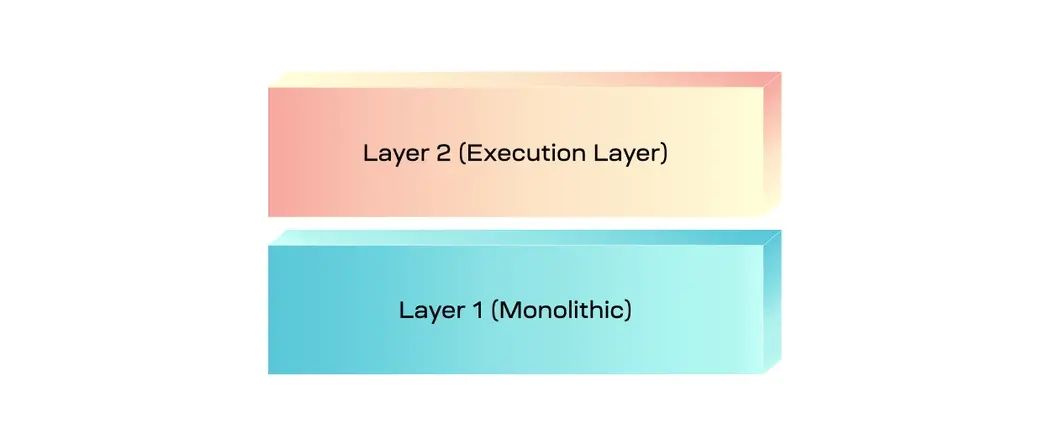
Figure 1 Layer1 and Layer2 architecture
Layer 1 and Layer 2: Celestia refers to it as naive modularization, initially designed for the scalability of Ethereum as a monolithic Layer 1, with Layer 2 focusing on execution, while Layer 1 provides other key functions.
- Celestia supports chains built using the Celestia as the DA layer based on the Arbitrum Orbit, Optimism Stack, and Polygon CDK (soon to be supported) technology stack. Existing Layer 2 can switch from publishing data to Ethereum to publishing data to Celestia using Rollup technology. Commitments to blocks are published on Celestia, which is more scalable than the traditional method of publishing data to a single chain.
- Celestia supports RollApps (chains dedicated to applications) constructed based on the Dymension technology components as the execution layer. Similar to Ethereum's Layer 1 and Layer 2 concept, the settlement layer of RollApps depends on Dymension Hub (to be explained later), DA layer uses Celestia, and chains interact with each other through the IBC protocol (based on Cosmos SDK, a protocol that allows blockchains to communicate with each other. Chains using IBC can share any type of data as long as it is encoded in bytes).
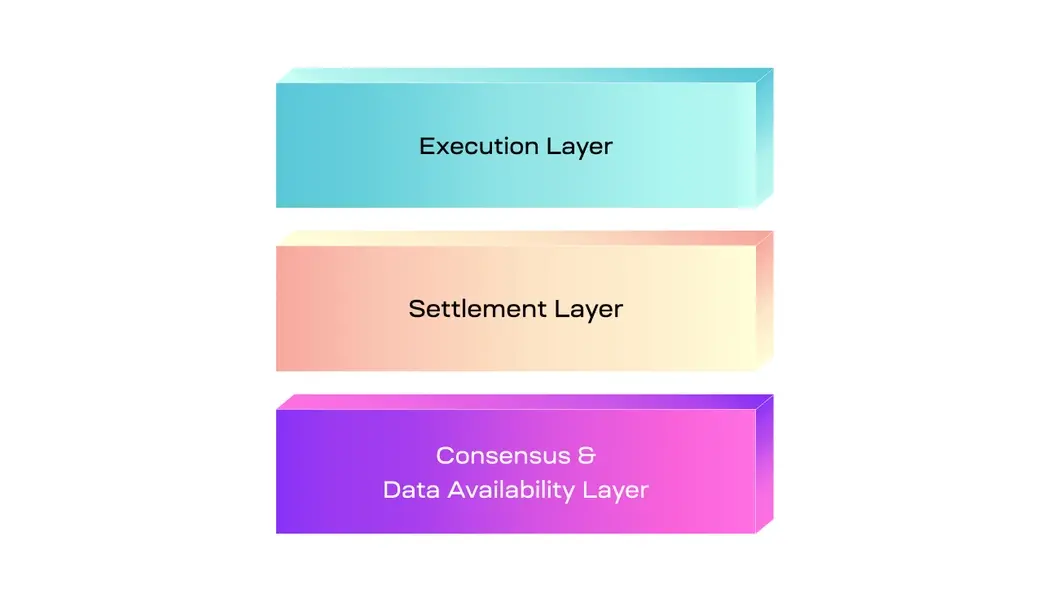
Figure 2: Execution, Settlement, and DA layer architecture
Execution, Settlement, and Data Availability: Optimized modular blockchain, where execution, settlement, and data availability layers can be decoupled into specialized modular blockchains.
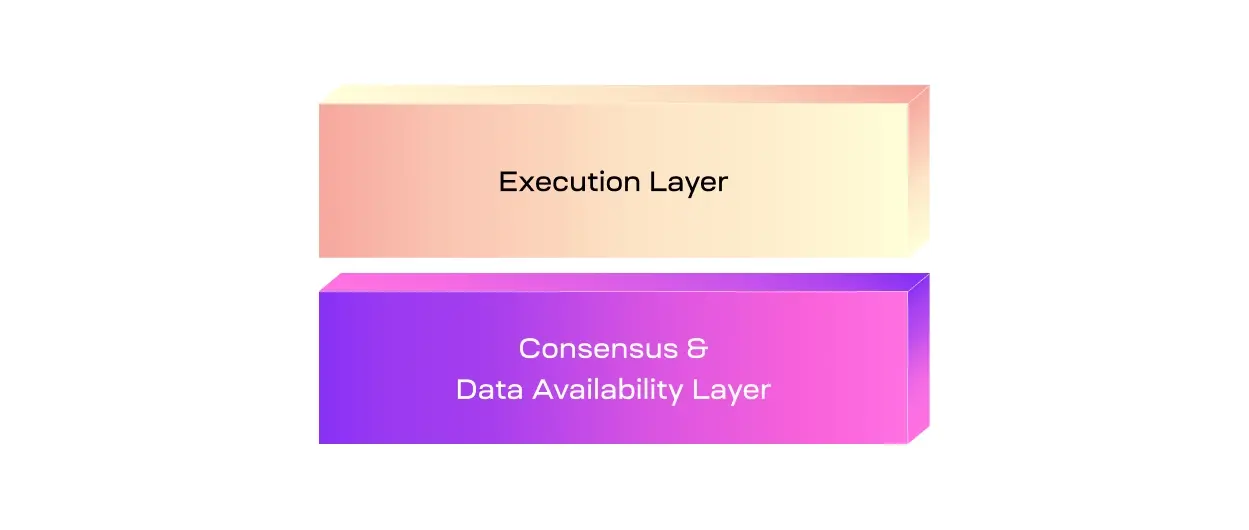
Figure 3: Execution and DA layer architecture
Execution and DA: Since the purpose of implementing modular blockchain is flexibility, the execution layer is not limited to publishing its blocks to the settlement layer. For example, a modular stack can be created that does not involve the settlement layer, only the execution layer above the consensus and data availability layers.
In this modular stack, the execution layer will be sovereign, publishing its transactions to another blockchain, typically used for ordering and data availability, but handling its own settlement. In the context of the modular stack, sovereign Rollup is responsible for execution and settlement, while the DA layer handles consensus and data availability.
The difference between sovereign Rollup and smart contract Rollup is:
- Smart contract Rollup transactions are verified by smart contracts in the settlement layer. Transactions of sovereign Rollup are verified by nodes of sovereign Rollup.
- In contrast to smart contract Rollup, nodes of sovereign Rollup have sovereignty. In sovereign Rollup, the ordering and validity of transactions are managed by the Rollup's own network, independent of a separate settlement layer.
Currently, Rollkit and Sovereign SDK provide a framework for deploying sovereign Rollup testnets on Celestia.
III. Exploring Modular Solutions in the Blockchain Ecosystem
1. Execution Layer Modularization
Before introducing execution layer modularization, we should understand what Rollup technology is.
Currently, execution layer modularization technology mainly relies on Rollup, which is a scaling solution that operates outside the Layer1 chain. This solution executes transactions off-chain, meaning it occupies less block space, and is one of Ethereum's important scaling solutions. After executing transactions, it sends a batch of transaction data or execution proofs to Layer1 for settlement. Rollup technology provides a scalability solution for Layer1 networks while maintaining decentralization and security.
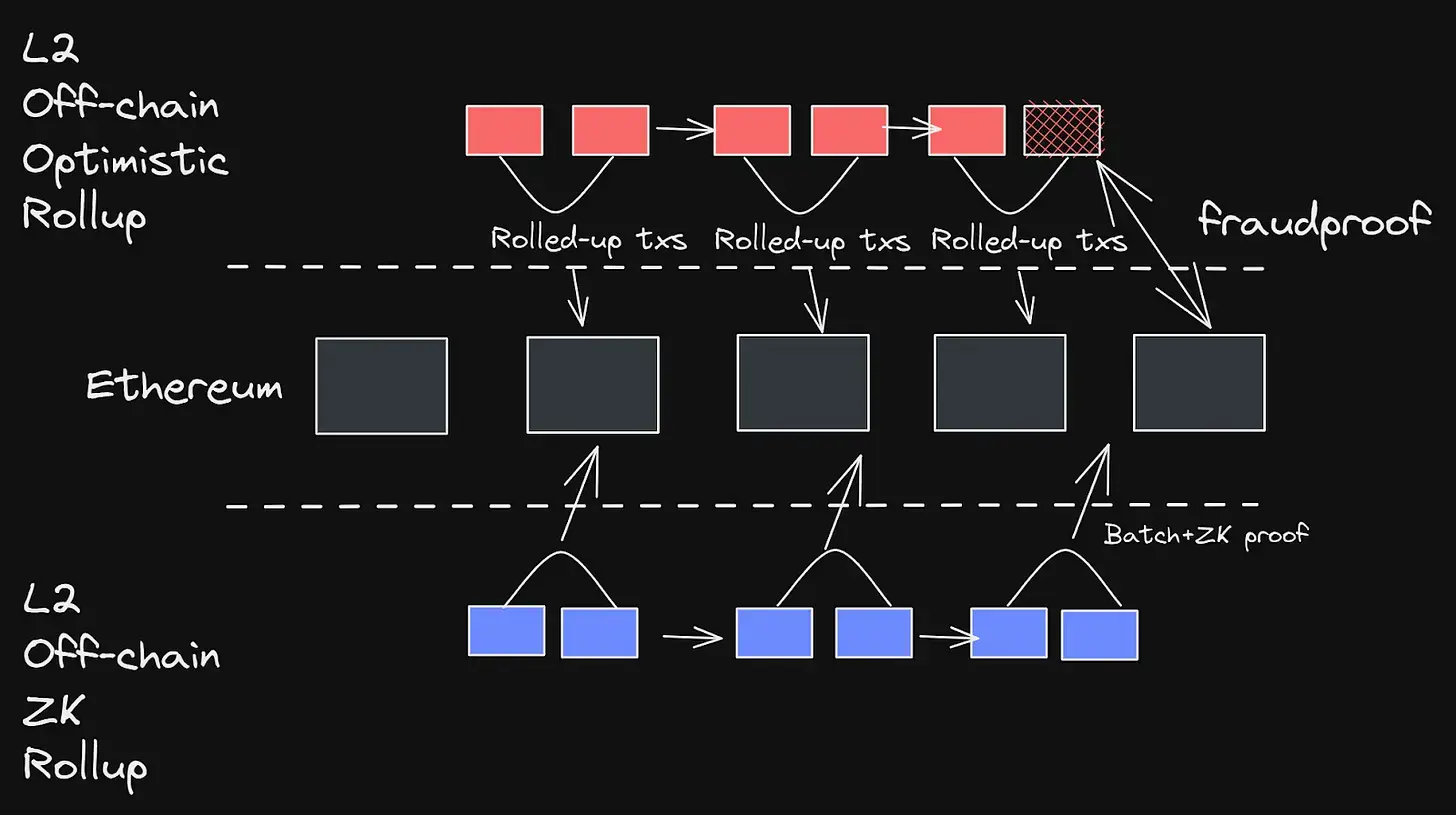
IV. Rollup Technology Architecture
Taking Ethereum as an example, Rollup technology can further improve performance and privacy by using ZK-Rollup or Optimistic Rollup.
- ZK-Rollup uses zero-knowledge proofs to verify the correctness of bundled transactions, ensuring transaction security and privacy.
- Optimistic Rollup assumes the validity of transactions before submitting the transaction state to the Ethereum main chain. During the challenge period, anyone can compute fraud proofs to verify transactions.
1.1 Ethereum Layer2: Building Future Scalability Solutions
Initially, Ethereum adopted side chains and sharding technology for scalability, but side chains sacrificed some decentralization and security to achieve high throughput. The development of Layer 2 Rollups has progressed much faster than expected, providing a significant amount of scalability and will offer more after implementing Proto-Danksharding. This means that there is no longer a need for "sharded chains," which have been removed from Ethereum's roadmap.
Ethereum outsources the execution layer to Layer2s based on Rollup technology to relieve the main chain's burden. The EVM provides a standardized and secure execution environment for smart contracts executed on the Rollup layer. Some Rollup solutions are designed with EVM compatibility in mind, allowing smart contracts executed on the Rollup layer to still utilize EVM features and functionality, such as OP Mainnet, Arbitrum One, and Polygon zkEVM.
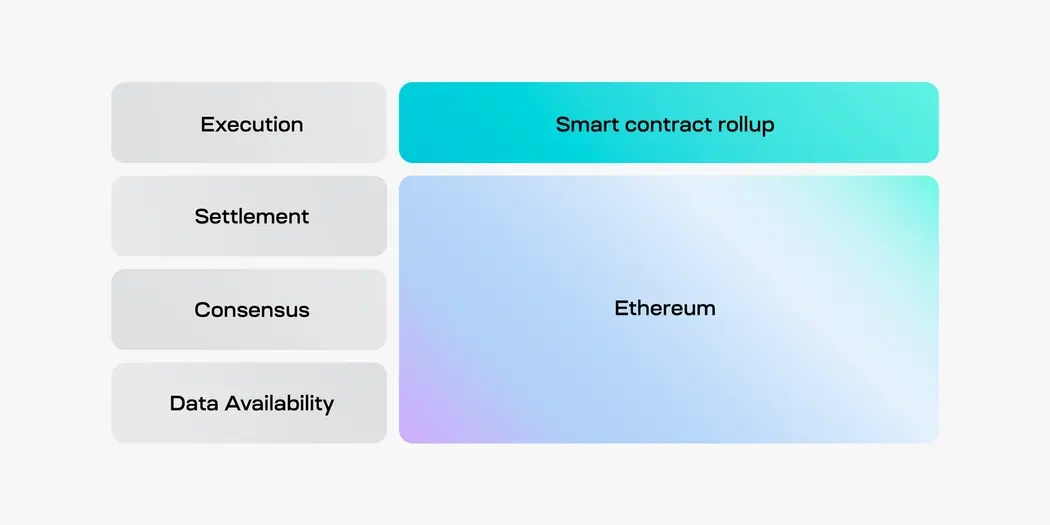
Figure 5: Ethereum's Layer 2 Scalability Solutions
These Layer2s execute smart contracts and process transactions, but still rely on Ethereum for the following operations:
Settlement: All Rollup transactions are settled on the Ethereum mainnet. Users of Optimistic Rollups must wait for the challenge period to pass, or transactions are considered valid after anti-fraud computation. Users of ZK Rollups must wait for proof of validity.
Consensus and Data Availability: Rollups publish transaction data to the Ethereum mainnet in the form of CallData, allowing anyone to execute Rollup transactions and reconstruct their state when necessary. Before confirmation on the Ethereum main chain, Optimistic Rollups require a significant amount of block space and a 7-day challenge period. ZK Rollups provide instant finality and store available data for verification for 30 days, but require significant computational power to create proofs.
1.2 B² Network: Pioneering Bitcoin ZK-Rollup
B² Network is the first ZK-Rollup on Bitcoin, increasing transaction speed without sacrificing security. Using Rollup technology, B² Network provides a platform for running Turing-complete smart contracts for off-chain transactions, improving transaction efficiency and minimizing costs.
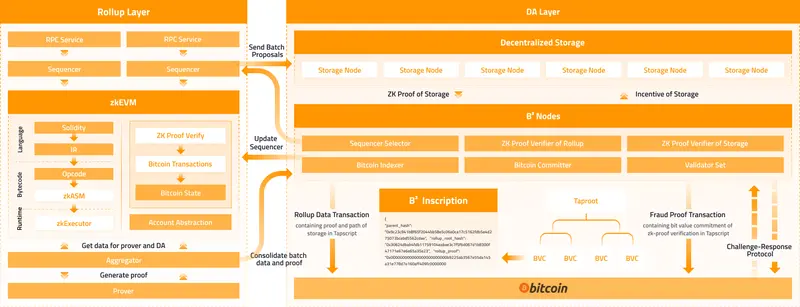
Figure 6: B² Network Architecture
As shown in the diagram, the ZK-Rollup Layer of B² Network uses the zkEVM solution, responsible for executing user transactions within the Layer2 network and outputting related proofs.
Unlike other Rollups, B² Network's ZK-Rollup consists of multiple components, including Account Abstraction Module, RPC Service, Mempool, Sequencers, zkEVM, Aggregators, Synchronizers, and Prover. The Account Abstraction Module implements native account abstraction, allowing users to programmatically incorporate higher security and better user experience into their accounts. zkEVM is compatible with EVM and can help developers migrate DApps from other EVM-compatible chains to B² Network.
Synchronizers ensure that information is synchronized from B² nodes to the Rollup layer, including sequence information, Bitcoin transaction data, and other details. B² nodes act as off-chain validators, performing multiple unique functions within the B² Network. The Bitcoin Committer module in B² nodes constructs a data structure to record B² Rollup data and generates a Tapscript called "B² ciphertext." The Bitcoin Committer then sends a UTXO of one satoshi to a Taproot address containing the "B² ciphertext," and the Rollup data is written to Bitcoin.
Additionally, the Bitcoin Committer sets a time-locked challenge, allowing challengers to question the commitment of zk proofs. If there are no challengers during the time lock period or the challenge fails, the Rollup is confirmed on Bitcoin; if the challenge succeeds, the Rollup is rolled back.
Whether it's Ethereum or Bitcoin, fundamentally, Layer1 is a single chain that receives extended data from Layer2. In most cases, the capacity of Layer 2 also depends on the capacity of Layer1. Therefore, the implementation of Layer1 and Layer2 stacks is not ideal for scalability. When Layer1 reaches its throughput limit, Layer2 is also affected, which can lead to increased transaction fees and longer confirmation times, affecting the efficiency and user experience of the entire system.
2. DA Layer Modularization
In addition to Celestia's DA solution being favored by Layer2s, other innovative solutions focused on DA have emerged and played a crucial role in the entire blockchain ecosystem.
2.1 EigenDA: Empowering Rollup Technology
EigenDA is a secure, high-throughput, and decentralized DA service inspired by Danksharding. Rollup can publish data to EigenDA, providing lower transaction costs, higher transaction throughput, and secure composability throughout the EigenLayer ecosystem.
When Ethereum Rollup builds decentralized temporary data storage, data storage can be directly handled by EigenDA operators. Operators participate in network operations, responsible for processing, verifying, and storing data. EigenDA can scale horizontally with the increase in staking and operators.
EigenDA combines Rollup technology and shifts the DA part to off-chain processing to achieve scalability. Therefore, actual transaction data no longer needs to be replicated and stored on every node, reducing the bandwidth and storage requirements. On-chain, only metadata and accountability mechanisms related to data availability are processed (accountability ensures that data is stored off-chain and can be verified for integrity and authenticity when necessary).
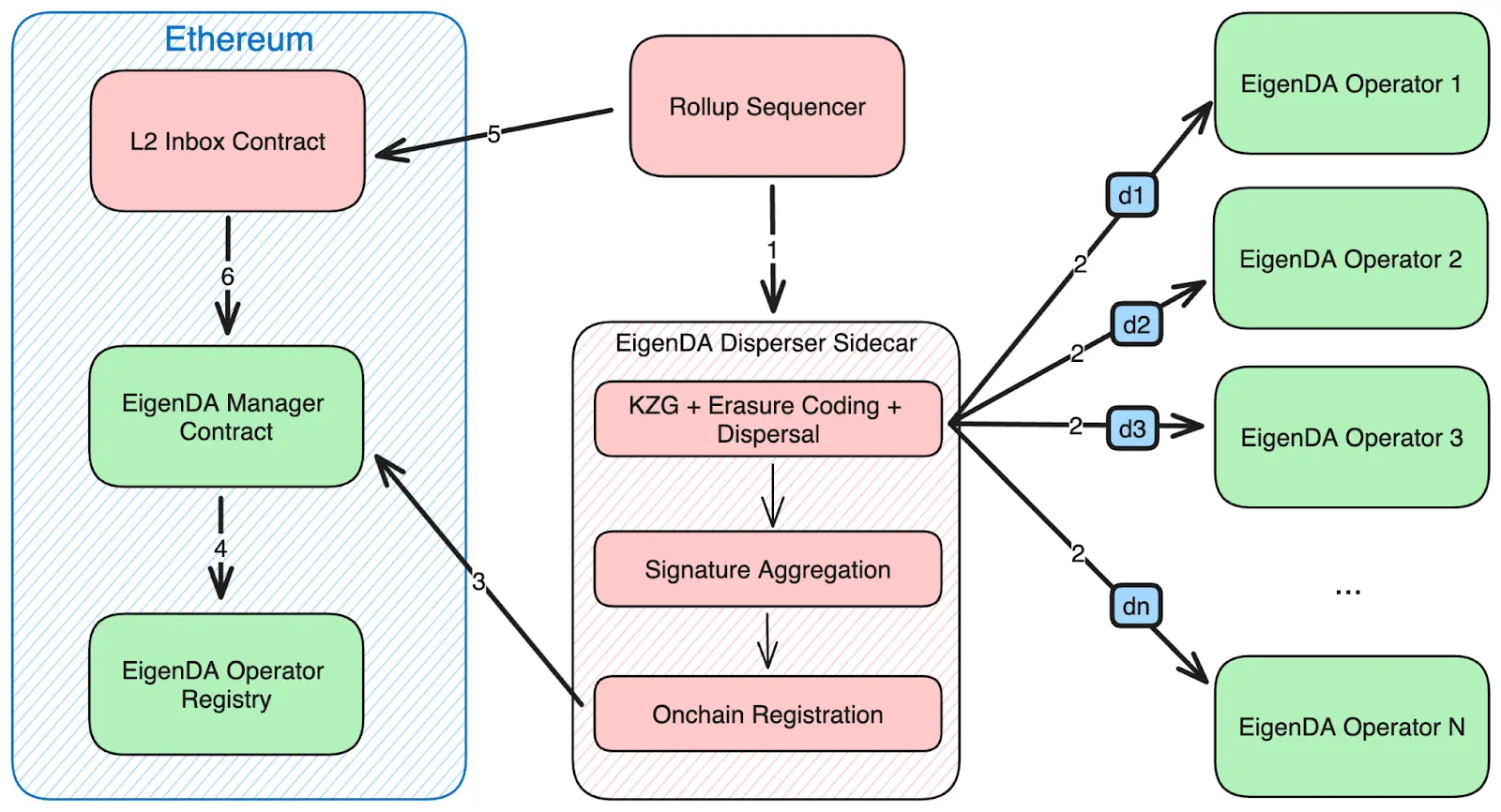
Figure 7: Basic Data Flow of EigenDA
As shown in the diagram, Rollup writes transaction batches to the DA layer. Unlike systems that use fraud proofs to detect malicious data, EigenDA divides data into blocks and generates KZG commitments and multiple reveal proofs. EigenDA requires nodes to download only a small amount of data [O(1/n)] instead of the entire blob. Rollup's fraud arbitration protocol can also verify whether the blob data matches the KZG commitment provided in EigenDA's proof. During this verification, the Layer2 chain ensures that transaction data of the Rollup state root is not manipulated by sequencers/proposers.
2.2 Nubit: The First Modular DA Solution on Bitcoin
Nubit is a scalable, Bitcoin-native DA layer. Nubit is pioneering the future of Bitcoin-native, aiming to improve data throughput and availability services to meet the growing needs of the ecosystem. Their vision is to integrate the vast developer community into the Bitcoin ecosystem and provide them with scalable, secure, and decentralized tools.
The team behind Nubit consists of professors and doctoral students from UCSB (University of California, Santa Barbara), with outstanding academic reputation and global influence. They are not only proficient in academic research but also have rich experience in blockchain engineering implementation. The team, together with domo (creator of Brc20), co-authored a paper on modular indexers, integrating the design of the DA layer into the indexer structure of the Bitcoin meta protocol, contributing to the establishment and formulation of industry standards.
Nubit's core innovations include consensus mechanisms, trustless bridging, and data availability. It leverages innovative consensus algorithms and the Lightning Network to inherit Bitcoin's fully censorship-resistant characteristics and improve efficiency using DAS:
Consensus Mechanism: Nubit explores an efficient consensus based on PBFT (Practical Byzantine Fault Tolerance) supported by SNARK for signature aggregation. The PBFT scheme combined with zkSNARK technology significantly reduces the communication complexity of verifying signatures between validators, verifying transaction correctness without needing access to the entire dataset.
DAS: Nubit's DAS is achieved through multiple rounds of random sampling of a small portion of block data. Each successful sampling round increases the likelihood of complete data availability. Once the confidence level is reached, the block data is considered accessible.
Trustless Bridge: Nubit uses a Trustless Bridge that utilizes the Lightning Network's payment channels. This method not only aligns with local Bitcoin payment methods but also does not add additional trust requirements. Compared to existing bridging solutions, it brings lower risk to users.
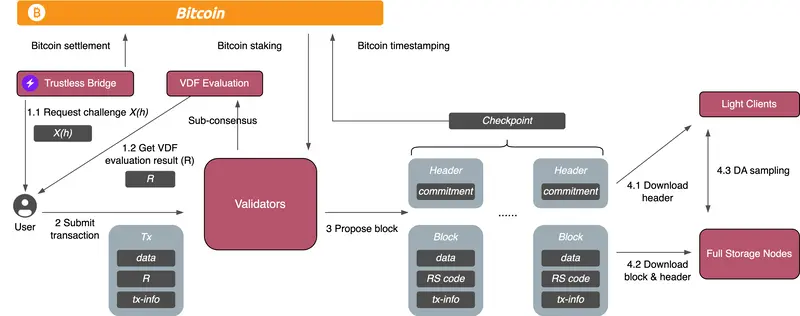
Figure 8: Basic Components of Nubit
We further review the complete system lifecycle shown in Figure 8 with a specific use case. Suppose Alice wants to complete a transaction using Nubit's DA service (Nubit supports various data types, including but not limited to ciphertext, Rollup data, etc.).
Step 1.1: Alice first needs to continue the service by paying gas fees through Nubit's trustless bridge. Specifically, Alice needs to obtain a public challenge X (h) from the trustless bridger, where X is the hash of a verifiable delay function (VDF) in the range to the challenge domain, and h is the hash value of a block at a certain height.
Step 1.2 and Step 2: Alice must obtain the evaluation result R related to the current round of VDF, submit R and her data and transaction metadata (such as address and nonce) to the validators to merge it into the mempool.
Step 3: Validators propose the process of blocks and their headers after reaching consensus. The block header includes a commitment to the data and its related Reed-Solomon Coding (RS Code), while the block itself contains the raw data, corresponding RS Code, and basic transaction details.
Step 4: The lifecycle ends with Alice's data retrieval. The light client downloads block headers, while the full node retrieves blocks and their headers.
The light client undertakes the DAS process to verify data availability. Additionally, after proposing a threshold number of blocks, checkpoints of this history are recorded on the Bitcoin blockchain via Bitcoin timestamps. This ensures that the validator set can prevent potential remote attacks and support rapid unbonding.
3. Other Solutions
In addition to chains focused on modularizing specific layers, decentralized storage services can provide long-term support for the DA layer. There are also protocols and chains that provide developers with customized and full-stack solutions, enabling users to easily build their own chains, even without code construction.
3.1 EthStorage - Dynamic Decentralized Storage
EthStorage is the first modular Layer2 that implements dynamic decentralized storage, providing DA-driven programmable key-value (KV) storage at a cost of 1/100 to 1/1000 to scale programmable storage to hundreds of TB or even PB. It provides long-term DA solutions for Rollups and opens up new possibilities for fully on-chain applications such as games, social networks, and AI.
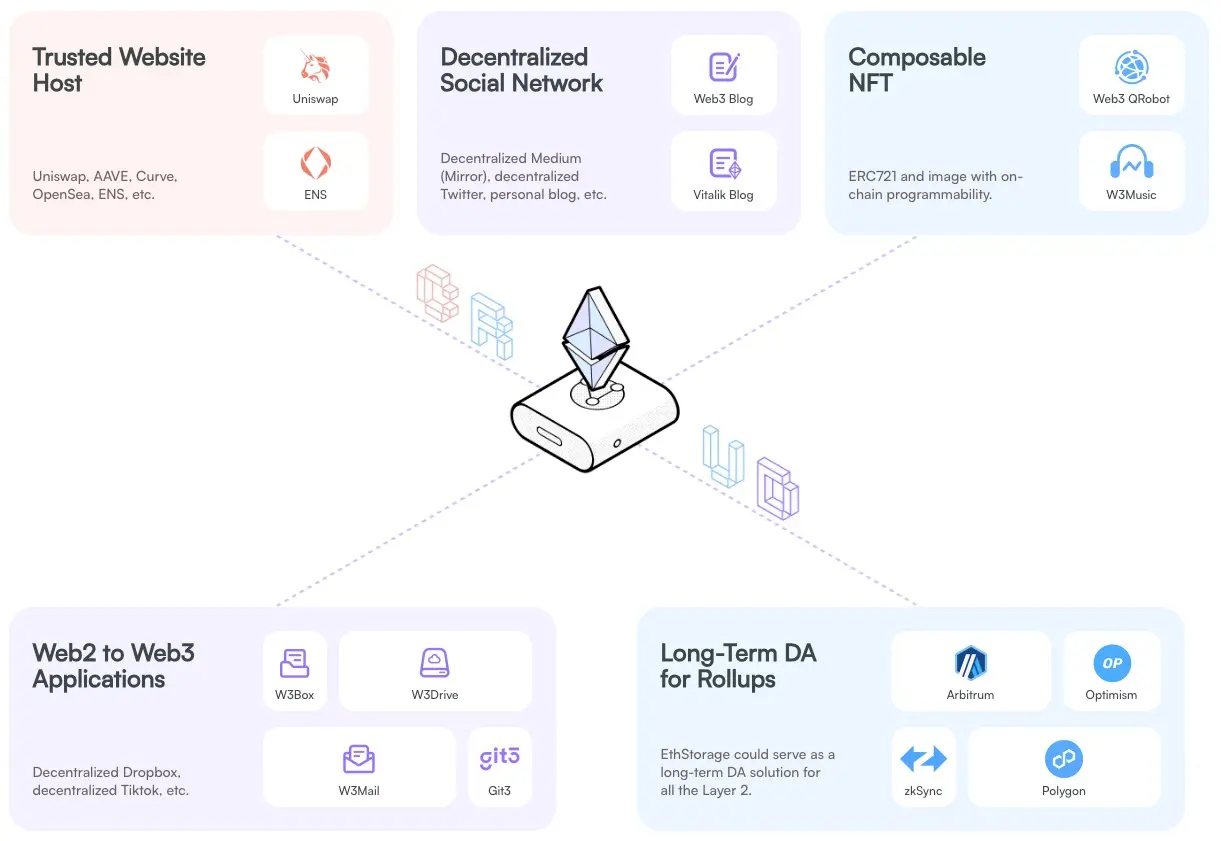
Figure 9: Application Scenarios of EthStorage
The founder of EthStorage, Qi Zhou, has been fully dedicated to the Web3 industry since 2018, holding a Ph.D. from the Georgia Institute of Technology and having worked as an engineer at top companies such as Google and Facebook. The team has also received support from the Ethereum Foundation.
As one of the core features of the Ethereum Cancun upgrade, EIP-4844 (also known as Proto-dank sharding) introduces temporary data blocks (blobs) for Layer2 Rollup storage, improving the network's scalability and security. The network does not need to validate every transaction in a block, only confirming whether the attached blob carries the correct data, significantly reducing the cost of Rollup. However, blob data is only temporarily available, meaning it will be discarded within a few weeks. This has a significant impact: Layer2 cannot unconditionally derive the latest state from Layer1. If a certain segment of data cannot be retrieved from Layer1, it may not be possible to synchronize the chain through Rollup.
With EthStorage as a long-term DA storage solution, Layer2s can retrieve complete data from its DA layer at any time.
Technical Features:
EthStorage can achieve decentralized dynamic storage: Existing decentralized storage solutions can support the upload of large amounts of data but cannot modify or delete it, only re-upload new data. EthStorage, through its original key-value storage paradigm, implements CRUD functionality, significantly enhancing data management flexibility.
DA layer-based Layer2 decentralized solution: EthStorage is a modular storage layer that can run on any blockchain as long as there is an EVM and DA to reduce storage costs (but many current Layer1s do not have a DA layer), and even on Layer2.
High integration with ETH: EthStorage's client is a superset of the Ethereum client Geth, meaning that when running nodes of EthStorage, they can still participate in any Ethereum process as usual. A node can be a validator node of Ethereum and a data node of EthStorage at the same time.
Workflow of EthStorage:
Users upload their data to the application contract, which then interacts with the EthStorage contract to store the data.
In the EthStorage Layer2 network, storage providers receive notifications about the data waiting to be stored.
Storage providers download the data from the Ethereum data availability network.
Storage providers submit storage proofs to Layer1, proving that there are a large number of copies in the Layer2 network.
The EthStorage contract rewards storage providers who successfully submit storage proofs.
3.2 AltLayer - Modular Customized Services
AltLayer provides a versatile, no-code Rollups-as-a-Service (RaaS) solution. The RaaS product is designed for the multi-chain and multi-VM world, supporting EVM and WASM. It also supports different Rollup SDKs, such as OP Stack, Arbitrum Orbit, Polygon zkEVM, ZKSync's ZKStack, and Starkware, different shared ordering services (such as Espresso and Radius), and different DA layers (such as Celestia, EigenLayer), as well as many other modular services at different layers of the Rollup stack.
AltLayer enables a versatile Rollup stack, for example, a Rollup designed for applications can be built using Arbitrum Orbit and use Arbitrum One as the DA and settlement layer, while another Rollup designed for general purposes can be built using ZK Stack and use Celestia as the DA layer, with Ethereum as the settlement layer.
Note: You might wonder why the settlement layer can be implemented by OP and Arbitrum. In fact, the Rollup stacks of these Layer2s are currently implementing "interchain" work similar to what Cosmos proposed to achieve interconnectivity: OP has proposed Superchain, and OP Stack as a standardized development stack supporting Optimism technology, integrating different Layer2 networks to promote interoperability between these networks; Arbitrum has proposed the Orbitchain strategy, allowing the creation and deployment of Layer3 on the Arbitrum mainnet based on Arbitrum Nitro (technology stack), also known as application chains. Orbit Chains can settle directly to Layer2s or directly to Ethereum.
3.3 Dymension - Full-Stack Modularization
Dymension is a modular blockchain network based on the Cosmos SDK, aiming to ensure the security and interoperability of RollApps using the IBC standard.
Dymension divides blockchain functionality into multiple layers, with Dymension Hub serving as the settlement and consensus layer for RollApps to provide security, interoperability, and liquidity, and RollApp as the execution layer. The data availability layer is supported by DA providers in the Dymension protocol, allowing developers to choose the appropriate data availability provider based on their needs.
Settlement Layer (Dymension Hub) maintains the registry of RollApps and relevant information such as state, sequencer list, current active sequencer, execution module verification, etc. The logic of Rollup services is fixed within the settlement layer, forming a native interoperable center. Dymension Hub as the settlement layer has the following features:
Local provision of Rollups services on the settlement layer: Provides the same trust and security assumptions as the underlying layer but with a simpler, more secure, and more efficient design space.
Communication and transactions: Dymension's RollApp implements Inter-RollApp communication and transactions on the settlement layer through embedded modules, providing trust-minimized bridging. In addition, RollApps can communicate with other chains enabled with IBC through the Hub.
RVM (RollApp Virtual Machine): The settlement layer of Dymension initiates RVM in case of fraud disputes. RVM can resolve disputes in various execution environments (such as EVM), expanding the capability and flexibility of RollApp execution.
Censorship resistance: Users who have undergone Sequencer review can submit a special transaction to the settlement layer. This transaction is forwarded to the Sequencer and requests execution within a specified time range. If the transaction is not processed within the specified time, the Sequencer will be penalized.
AMM (Automated Market Maker): Dymension introduces an embedded AMM in the settlement center, creating a core financial center and providing shared liquidity for the entire ecosystem.
IV. Comparison of Modular Blockchain Ecosystems
In the previous sections, we delved into modular blockchain systems and numerous representative projects. Now, we will focus on the comparative analysis between different ecosystems, aiming to gain an objective and comprehensive understanding of modular blockchains.
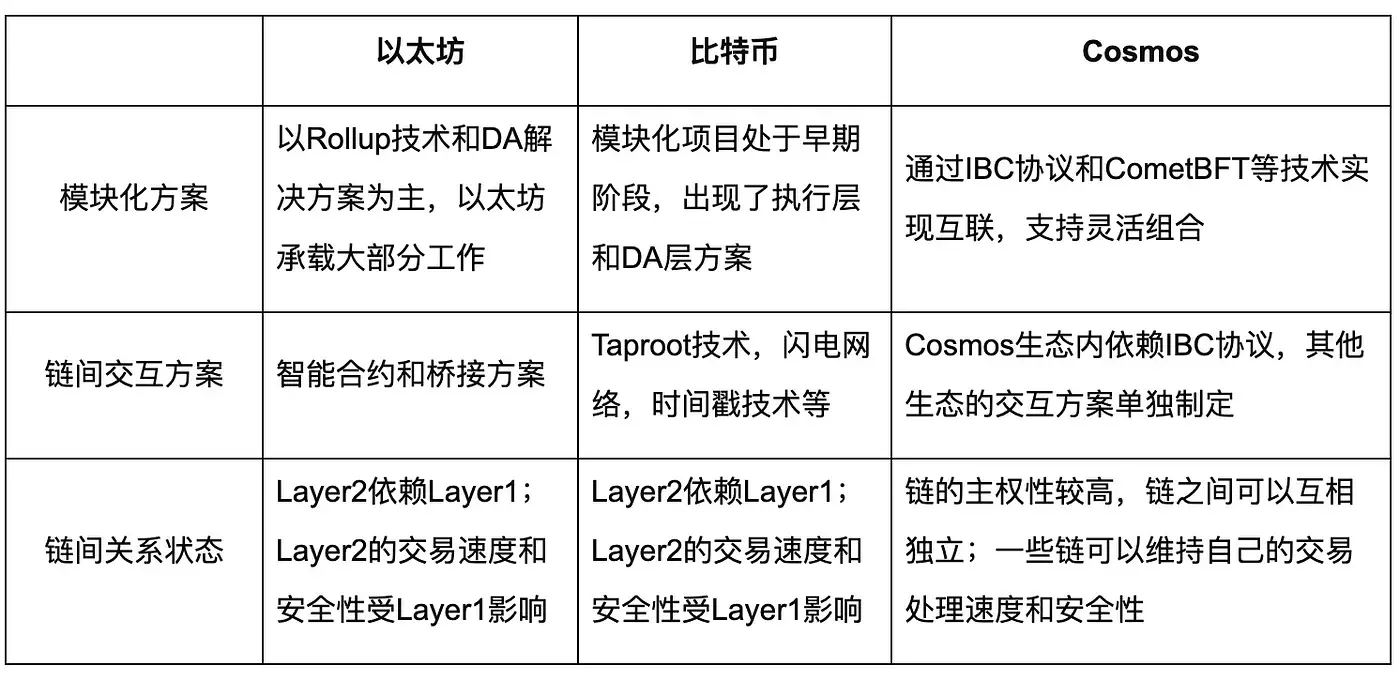
V. Conclusion and Outlook
As we have seen, the blockchain ecosystem is evolving towards modularity. In the past blockchain world, individual chains operated in isolation, competing with each other, making it difficult for users, developers, and assets to flow between different chains, limiting the overall development and innovation of the ecosystem. In the WEB3 world, the discovery and resolution of problems is a collaborative process. Initially, Bitcoin and Ethereum attracted a lot of attention as single chains, but as the shortcomings of single chains were exposed, modular chains gradually gained attention. Therefore, the explosion of modular chains is not accidental but inevitable for development.
Modular blockchains enhance the flexibility and efficiency of chains by allowing each component to be independently optimized and customized. However, this architecture also faces challenges, such as increased communication latency and complexity of system interaction. In practice, the long-term benefits of modular architecture, such as improved maintainability, reusability, and flexibility, often outweigh its short-term performance losses. In the future, as technology develops, these issues will find better solutions.
GeekCartel believes that blockchain ecosystems have a responsibility to provide reliable foundational layers and general tools throughout the entire modular stack to facilitate smooth connections between chains. If ecosystems can be more harmonious and interconnected, users will be able to more easily use blockchain technology, and it will attract more new users to Web3.
免责声明:本文章仅代表作者个人观点,不代表本平台的立场和观点。本文章仅供信息分享,不构成对任何人的任何投资建议。用户与作者之间的任何争议,与本平台无关。如网页中刊载的文章或图片涉及侵权,请提供相关的权利证明和身份证明发送邮件到support@aicoin.com,本平台相关工作人员将会进行核查。




